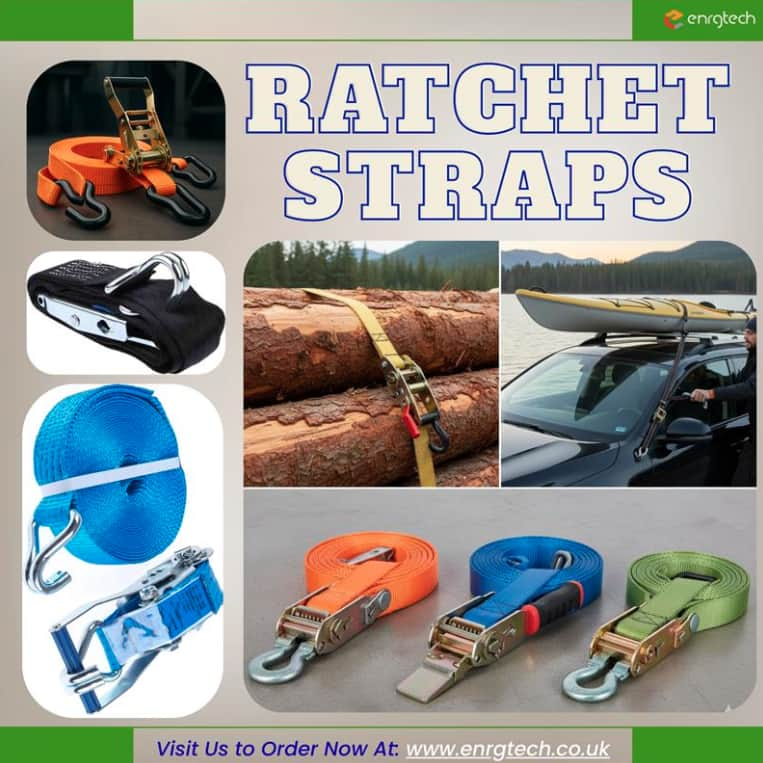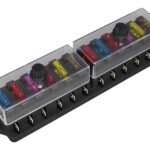
Introduction
Everyday transport is full of variables—speed, wind, potholes, sudden stops. Also, in logistics, facilities, trades, and couriers, the difference between “arrived” and “arrived safely” truly matters. The ratchet strap measures this safety difference. This article covers the fundamentals of ratchet straps, illustrating the practical, real-world scenarios where they make everyday work simpler and more secure.
Defining Ratchet Straps: Why are They a Must-Have Tool?
They are also commonly called tie down straps, are versatile fastening tools defined by two main components: a long length of webbing and a mechanical ratcheting buckle. These straps are designed to secure loads during transport, storage, and lifting, among other applications. A ratchet strap, as the name implies, comes equipped with a ratchet mechanism, allowing users to tighten the strap with controlled force. This mechanism prevents the load from slipping or loosening, ensuring robust stability.
What makes these tie down straps a must-have is their combination of reliability, strength, and ease of use. They prevent movement, reduce the risk of damage, and enhance overall safety when handling heavy or awkward loads. Their dependable hold with a very high-holding force makes them a must-have for anyone involved in moving, hauling, or trailering.
Most Standard Types of Ratchet Straps Available Today
Ratchet straps come in several standard types categorised primarily by their width and the end fittings they use. These variations determine the strap’s strength and where it can be anchored. Some of the popular variants include:
- Ratchet Straps with Hooks
Ratchet straps with hooks are designed for secure and reliable load fastening, offering quick attachment to anchor points such as rings, rails, or frames. These straps include durable metal hooks at each end to ensure a firm grip and prevent slippage, making them suitable for transport, storage, construction, logistics, and general cargo handling.
- Ratchet Straps Based on End Fittings
Ratchet straps vary widely by end fittings, each engineered for specific load-securing needs. Choices include claw hooks, J-hooks, S-hooks, D-rings, and loop ends—each providing unique anchoring compatibility. Selecting the right end fitting ensures proper load restraint, improved safety, and ease of use across different applications and tie-down environments.
- Ratchet Straps Based on Assembly Type
Ratchet straps are available in different assembly types, typically defined by how the webbing and fittings are configured. Common options include retractable ratchet straps and two-piece straps (with a ratchet on one side and a hook on the other). Endless loop straps are also available, a continuous strap with integrated tension control. The right assembly type supports efficient load securing, streamlined handling, and reliable operational performance.
Ratchet Straps Matter in Professionals & Everyday Applications
They are common in everyday use due to their advanced features and unparalleled benefits. Some of the main areas include:
- Superior Security and Stability in Transit
The primary and most critical use of ratchet straps is securing cargo during transportation. Whether you are a professional hauler or a homeowner moving furniture, the ability to lock a load down firmly is paramount. These straps prevent load shift, protect goods, and adhere to safety requirements. Whether transporting sensitive or fragile items and handling heavy machinery or household appliances, tie down straps are especially vital.
- Domestic and DIY Applications
Beyond the highway, ratchet straps prove their worth in countless everyday scenarios around the home, garage, and on recreational trips. When moving house, bulky items like refrigerators, dressers, and sofas, cargo lashing straps keep them firm and prevent costly scratches, dents, and breaks. They are also indispensable for recreational and outdoor gear, such as kayaks, canoes, bicycles, and camping equipment. The versatility of tie-down straps makes them a valuable addition to any homeowner’s or DIY enthusiast’s toolkit.
- Practical Utility in Projects and Repairs
The ratchet mechanism’s strength and tension-applying capability lend themselves to various practical projects and emergency fixes. They can serve as an extra-large clamp, providing even pressure to hold large woodworking projects. They can also be used for lighter recovery tasks or to secure a temporary spare tyre. Their ability to apply significant force is also useful for small structural adjustments or for temporarily tightening a loose component.
The Safety Significance of Ratchet Straps: Advantages Over Other Fastening Methods
Ratchet straps are fundamentally important fastening devices that offer significant advantages over traditional fastening methods. These straps are known as the safest and most dependable choice for securing everything. Standard ropes and bungee cords can loosen, slip, or rely heavily on user strength, which is a major cause of accidents during transport. In contrast, a ratchet strap is beneficial because it uses a geared tightening system, ensuring a firm, stable hold throughout transport or storage. They maintain constant pressure and prevent sudden load movement, significantly reducing the likelihood of accidents and protecting both users and their valuable assets.
Buying Guide: What to Look for When Purchasing Ratchet Straps
Choosing the right ratchet strap ensures reliability, safety, and ease of use. To make an informed decision, consider the following key factors:
- Stap Material Quality
- Working Load Limit (WLL) and Breaking Strength
- Length and Width
- Ratchet Mechanism Construction
- End Fittings and Hooks
- Safety and Durability
- Environmental Conditions
- Certification and Compliance
- Budget and Brand.
Bottom Lines
The significance of ratchet straps in everyday use goes beyond simple cargo security. From construction work and automotive use to warehouse and firefighting handling, they provide reliability, safety, and efficiency for countless applications. Investing in quality ratchet straps today ensures that your cargo—no matter how big or small—stays safe, secure, and exactly where it belongs.























